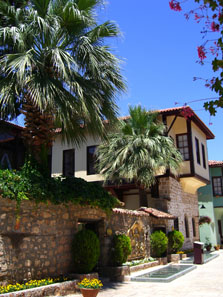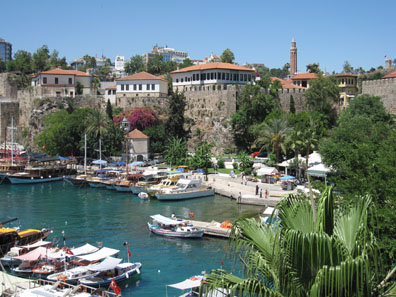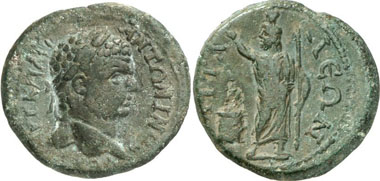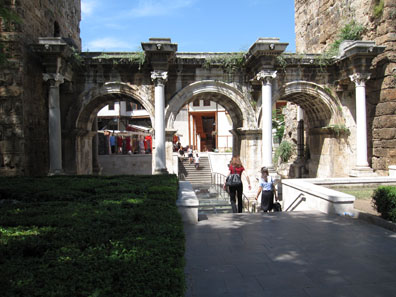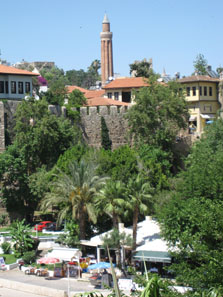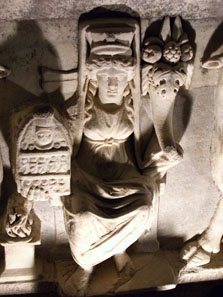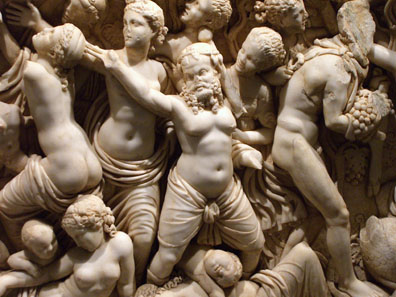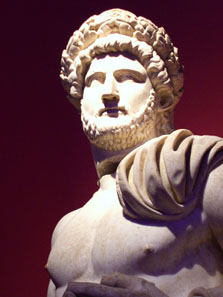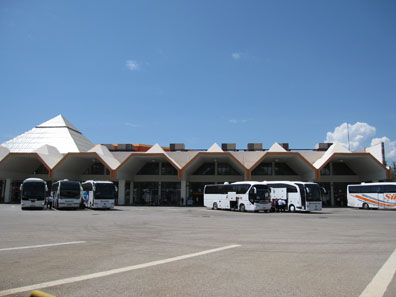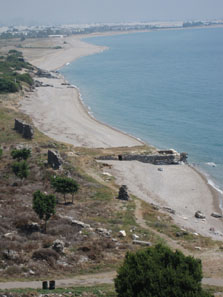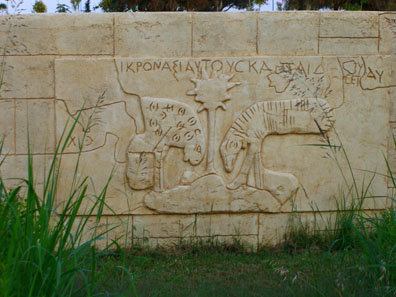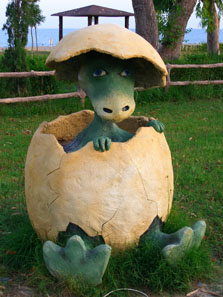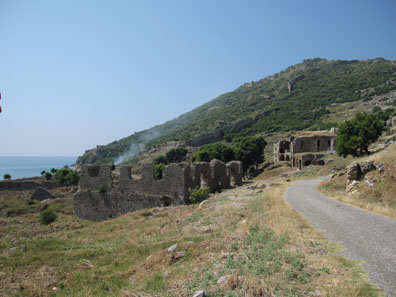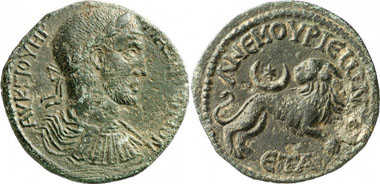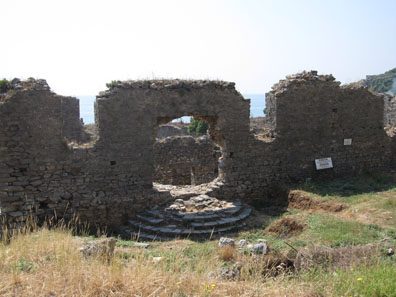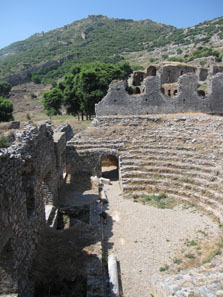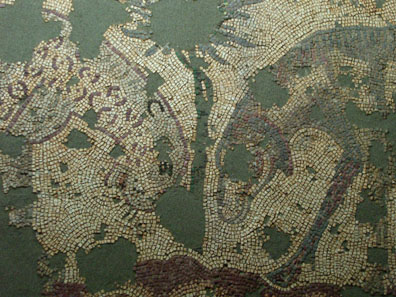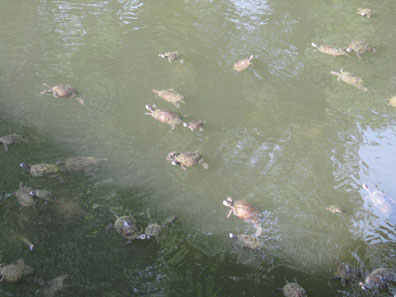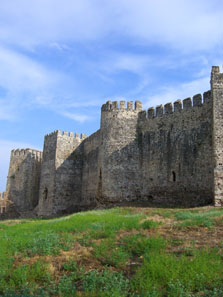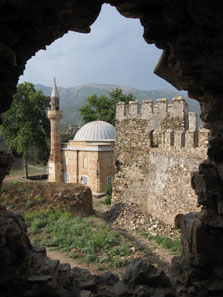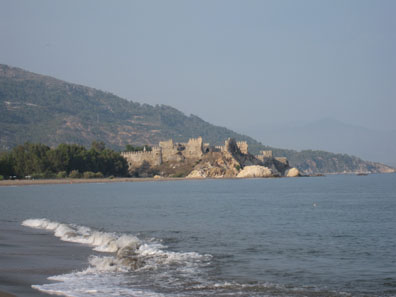by Ursula Kampmann
January 26, 2012 – It’s grey, it’s cold, it’s dark. Sometimes you don’t believe that it’s ever going to be light again. Enjoy a little breeze of the Turkish summer in the dead of winter. This diary of some numismatically highly interesting but barely visited sites in Turkey was written in 2009.
June 8, 2009 – Antalya
Today was the day. It started at the crack of dawn. The plane was due to leave at 6:20. We got up at 2:45 in order to arrive in time. The one not being in time was the airport. The check-in counters opened as late as half past four.
Our flight cautioned us as to what sort of people we were about to encounter in Antalya. Intriguing! We saw transvestites with long blond braids in a mangily green, short bathing suit, and this ensemble was tattooed all over. I wonder what the Turks have to say about that.
We arrived three and a half hours later. Unfortunately, we didn’t recognize Antalya airport. A huge building, entirely made of marble, casts of antique statues everywhere, an enormous fountain right at the center of the entrance hall – and an infrared camera to check on the fever of all tourists in a fast track procedure. Apparently, Turkey is highly afraid of pig flu.
Our hotel in Antalya. Photo: UK.
The very airport made clear that in Turkey nothing is what it used to be 20 years ago, and Antalya, too, is not the Antalya I used to know. A new city, wide and manicured boulevards, gigantic, marvelous, watered beds of flowers, impressive but not the Turkey I knew. The Turks, however, like their bathing-place, numerous local tourists are there as well.
Our hotel is nice and has a good location, it is rebuilt from an old Turkish house. The rooms were okay, there was a small swimming pool in a garden and flesh, heaps of flesh – no, not on the grill but at the swimming pool.
The harbour of Antalya. Photo: KW.
We put our luggage down and left for the city. Oh, it’s true what they say – only donkeys and Englishmen lie down in the sun at noon. It was boiling hot! The sweat was pouring down, the city was dead, even the waiter didn’t make much of an effort to pull us into their restaurants. We sat down at the harbor and watched. It truly was alarming to see how Antalya has changed, from an adoring fishing village into a fashionable spa. And the people! The most interesting ones are the beauties from the east. Enormous heaps of flesh, squeezed into tight, colorful skimpy dresses so that every bodily detail becomes readily identifiable.
Antalya’s public beach. Photo: KW.
We didn’t do much more on this first day. We slept for an hour, showered a couple of times, had a nice meal. In short, it took less than an hour for us to feel home again in Turkey.
June 9, 2009 – Antalya
We stayed the night in Antalya to acclimatize in Turkey again. We both had pleasant associations with the Archaeological Museum but we were horrified by the walk ahead. You see, the museum is pretty far away from the city center. But, Turkey has become modern, thus Antalya has a tramway now whose wagons were donated by a German sister city. Apparently, they were taken out of service in the 1950s, but it was such a pleasure to go the four kilometer or so comfortably instead of walking the distance.
Attaleia (Pamphylia). Caracalla, 211-217. Rv. Sarapis standing in front of an altar. SNG Aul. -. SNG PFPS -. SNG BN -. From auction Gorny & Mosch 196 (2011), 2155.
In ancient times, Antalya was called Attaleia. It was founded by Attalos II (159-138) who tried to get the cities of Pamphylia under his control that were part of the Pergamene Empire after the Peace of Apamea in 188.
Central part of Hadrian’s Gate. Photo: KW.
Pompey fought the pirates from this easily accessible harbor, and in 25 B. C. the city became the capital of the province of Pamphylia.
View over Antalya’s well reconstructed historic city. Photo: KW.
Attaleia remained important in Byzantine times, and under the Seljuks it even gained in importance. Their rulers chose Antalya as their winter residence. They expanded the fortifications, built a splendid harbor in addition and numerous mosques, Qu’ranic schools as well as a monastery for dervishs. Venice and Pisa were granted privileges, and consequently Antalya became an important commercial city. Venice would have liked very much to get Antalya entirely under its control and tried it again and again, by force of arms. It didn’t work out, though. At least, Antalya became part of the Italian Republic after the Treaty of Sèvres in 1920, albeit for a very short period of time.
Patron goddess of Perge with a statue of Artemis of Perge. Photo: UK.
Anyway, the Archaeological Museum is magnificent. It was awarded as Best Museum of Turkey in 1988 and houses objects from excavations in the vicinity as well. The friezes of the Theater of the city of Perge were breathtaking, fabulous quality and highly interesting. They depict a sacrificial procession for the city goddess who holds a statuette of Artemis in her hands. On the upper floor a gigantomachy was exhibited and a larger than life statue of Alexander the Great.
Detail of a sarcophagus. Photo: UK.
The big surprise was the sarcophagi with their freshness and quality as is rarely seen.
Statue of Hadrian. Photo: UK.
We took many pictures – under aggravated circumstances at that. To save energy, the lighting only switched on when a motion detector detected a visitor passing. In case that visitor is so bold as to stop walking no movement is detected and therefore the light switches off. It really wasn’t that easy, looking at a statue and don’t forget to pace forwards and backwards every 20 seconds to keep the lighting from switching off.
The afternoon was a complete disaster. We went to the bus station to find out which bus was heading for Anemourion. We had a sketchy site plan of the city … After we had walked for five minutes or so, a guy addressed us, in perfect German with a slight Berlin accent. Needless to say, I thought: great, we have found someone who knows where the bus station is and can show us. So I asked him and he was happy, agreed to lead us to the bus going to the out-of-town bus station. In fact, there would be a direct bus, but it wouldn’t be possible for us to find it and so on and so forth. Walking along the boiling hot boulevards of present-day Antalya, he bent our ears with a tear-jerking story: he grew up in Germany, returned to Turkey to do his military service, wants to go home to Germany, but is forced to stay here due to some regulations on residence, got stranded here, if he might lead us to bus going to the bus station, he so much likes to hear some German from time to time. Instantly, I melted away with sympathy. I started wondering if we ought to offer the young man a little bit of money or if he might refuse of pride. All the time I considered it we walked, the sun beat down, the streets were hot, the tongue stuck to the gums, and he walked and jabbered. At some point we arrived at a bus station that looked nothing different from the ones we had passed. Oppressive heat, no shade, and the guy asked rather bluntly if we could help him with a bit of money. So we did. And there we stood, and stood, because the promised direct bus didn’t arrive. And bit by bit it became clear that our guide had no idea whether or not the direct bus would stop here at all. He stopped every incoming bus, talked with the driver, once he told us to get inside a bus only to make us getting off again. We were fed up. Having paid our entrance fee for the tear-jerking story was enough already – standing in the burning sunshine for free wasn’t our cup of tea. So we took us by the hand, took one of the overpasses – without saying good-bye –, to get back to the old town again; by the way, we managed to get there much quicker than the way there, with our guide ‘who knew the place’. Well, therewith we bade farewell to Antalya inwardly.
June 10, 2009 – Anemourion
Next morning we departed for Anemourion. We reached the bus station of Antalya and were perplexed. We recalled a big square with lots of sheds serving as ticket counters. Instead of that, we saw a gigantic site, half an hour distant from the city center, which might well keep up with the airport.
Antalya’s bus terminal. Photo: KW.
Nevertheless, we found a bus. We handed off our luggage, received a receipt and looked for our reserved seats. What followed next was really impressive. Three young men provided for the guests. They all wore snow-white shirts, the two of higher rank a tie, the ‘apprentice’ a bow-tie, and the young man was always on the move. He brought ice-cream, water, tea, coke, rosewater, roughly every half an hour he presented us with something different, always being nice, always being affable. He looked curious for a Turk: blue eyes, blond hair, sticky-out ears – perhaps some crusader had been involved at some point? Despite of the exemplary care time hanged heavy on our hands. The trip to Alanya alone took approximately three hours.
What we saw along the coastal line was shocking! One holiday complex (all inclusive, of course) was lying next to the other. The free space between didn’t provide enough room for a narrow alley. That wasn’t the Turkey anymore we had come to know 20 years ago. Anyone staying in these bunkers geographically is in Turkey, all right, but the cultural environment he takes along with him from Germany. No sign of local atmosphere. We, on the other hand, experienced almost a bit too much local atmosphere. The bus ride was long, the music loud, the kids shouted – in short, there was nothing reminiscent of fun. Shortly behind Antalya, however, the freeway ended and the bus had to take the scenic coastal road, which took us to Anemourion, meandering quite a bit.
Anemourion Beach, in the background the modern city of Iskele. Photo: KW.
While sitting in the bus we decided that we wanted to go to a little suburb of Anamur – modern Anemourion –, to Iskele. As our guidebook told us, it was a small bathing enclave, visited mainly by Turkish tourists. We had already chosen a hotel, recommended by our book. The name was Shishec – and a taxi driver got us there, shaking his head.
Upon our arrival we understood the driver’s weariness. Shishec was a ramshackle hut. Four floors, the lift out of service and when the landlord’s daughter showed us the first room, there was only a shattered toilet bowl instead of a toilet. Not that attractive, this room. The second one had a bathroom functioning properly, admittedly, but the air condition wasn’t working. And that was enough. I turned around and left the charmless establishment.
Right next to it, there was a proud three star hotel named Hermes. The room was bearable, but I thought the price, 160 Lira (= 80 Euros) much too high. Kurt, however, was all run down, I was bushed, we were both sticky after the long bus ride – and so we took the room. There I started thinking. Kurt had understood 60 Lira, I, in contrast, 160. He thought that grossly overpriced, and I, after giving it some consideration, had to admit that he was right. Probably I had misunderstood it, and, in addition, the official price on the board had been lower. Hence, it was simply impossible that the price would have been 160 Lira.
The lady at the reception tended to disagree. She thought 160 Lira quite correct, wanted to make a special price for us at the most, i.e. 150 Lira – I pointed towards the sign stating 110 Lira for the room and became angry. Finally, I had to threaten to call the police to get our ID cards back. We left 10 Lira for the clean-up of the room and exited the hotel to find ourselves a much better room in a hotel close by which cost only one third.
June 11, 2009
The next day we were exhausted. As late as the evening we managed to wander the main road. Everything is so different from a German tourist area. The stores sell entirely different things. For example, it is impossible to get any postcards.
Iskele’s attractions. Photo: UK.
Apparently, Turkish tourists seldom write any cards. On the other hand, there were several supermarkets, but only a handful of restaurants: my well-informed book told me that the Turks, when being on holiday, usually bring their own food. A small business owner had set up a computer with a huge screen for the tourists to play computer games on the cheap.
The Turkish version of Jurassic Park. Photo: UK.
There was a Jurassic Park with miniature dinosaurs for the little Turks and a course which, on close inspection, consisted of particularly solid fitness equipment for the slightly elder Turks to do something for their six-pack.
We also saw some women bathing in swimsuits. The whole-body bathing suits some women had worn in Antalya we only rarely encountered.
We let the evening gently fade away in the hotel talking with our hosts.
June 12, 2009
Today we took a taxi that brought us to ancient Anemourion. It was a surprisingly big excavation that, I regret to say it, was completely overgrown with weeds and buried under garbage. The site is said to have good mosaics and several good frescoes.
View of the excavations of Anemourion. Photo: UK.
Unfortunately, we didn’t find them. At least, the location on the waterfront was charming, and the many lizards, locusts and birds animated the scenery.
Anemourion. Maximinus Thrax, 235-238. AE. Rv. Lion, above crescent. SNG BN 711. From auktion Gorny & Mosch 186 (2010), 1632.
Already in the 1st cent. B. C., Anemourion started to become an important commercial city. It flourished during the 2nd and 3rd centuries, albeit the ruins, three basilicas and numerous tombs mainly date to late Antique times, to the 3rd-5th centuries.
The odeion in old Anemourion. Photo: KW.
As late as Medieval times, Anemourion was still important being a trading post between Cyprus and the West – hence the Medieval fortress, built in the 12th cent. by the kings of Lesser Armenia. We planned on visiting it the following day.
The theatre with the panorama over the city walls. Photo: KW.
Oh well, it wasn’t that magnificent after all (perhaps that impression was due to the heat). As Kurt so aptly remarked after we returned home again, all these archaeological excavations look alike somehow. And even more so when there is barely any information available on site – being “backpackers” we had no chance of carrying heavy literature around with us.
So we recreated again on our balcony. Electricity failed – apparently, that is something of a normal condition around here. Our hosts told us about a season when electricity was failing for a fortnight – not a piece of cake since the four-storied hotel has a water pump for the showers, toilets and water basins that is operated by electricity.
Finds from the sea, in the museum of Anemourion. Photo: KW.
June 13, 2009
The next morning we visited the museum.
Mosaic from Anemourion. A modern reproduction of this mosaic is to be found at the seafront, see above. Photo: UK.
Well, whatever you call museum.
Tombstone from ancient Anemourion. Photo: UK.
The finds of Anemourion wasn’t overwhelming at all. We soon concluded our tour around the museum that had fallen into a deep sleep (I’d rather not think about how much time had passed since the last visitor had come). You can hardly call a single room full-length.
In the afternoon, the castle was the next up on the agenda. We were fascinated.
Turtle pond. Photo: KW.
Not by the castle but by the pond with hundreds of turtles swimming in it.
Crusader’s castle. Photo: UK.
The castle likewise was rather impressive. It was an enormous complex once owned by the Armenians which had settled in raw Cilicia after they had been expelled from their home in Central Anatolia by the Seljuks. The towers were still complete to some extent. By using one’s imagination one could envision the crusaders and their allies, the Armenians, being here.
A mosque in the inner ward of the castle. Photo: KW.
In the middle inner ward a small mosque is situated today, a spot of color in the stone desert.
We returned home by foot. There wasn’t a taxi in sight, anyway. So we started walking, and this stroll was marvelous.
The castle of Anemourion from some distance. Photo: KW.
It was as if we were the only persons in the world. Time and again we came across warning notices and areas that were fenced off with branches, presumably the places where the turtles lay their eggs. As a precaution, we gave these spots a wide berth. There were stints, and Kurt even claimed to have seen crabs – of course, I haven’t since I was too slow, as always.
The next issue we fail in Silifke and flee to the wonderful Antioch on the Orontes where a muddy river god is singing his dirge. Don’t miss the second part of the diary from Turkey!
You can read all other parts of this diary here.




